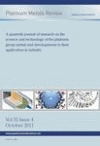-
oa Catalysts for Nitrogen Oxides Control under Lean Burn Conditions
The Opportunity for New Technology to Complement Platinum Group Metal Autocatalysts
- Source: Platinum Metals Review, Volume 36, Issue 1, Jan 1992, p. 2 - 11
-
- 01 Jan 1992
- Previous Article
- Table of Contents
- Next Article
Abstract
Regulations to control the exhaust emissions from motor vehicles are being adopted by more and more countries around the world, and in future more stringent regulations will be introduced, particularly in the U.S.A. and Europe. This, together with the need to show good pollution control under real-world driving conditions, has led to the widespread introduction of closed-loop, three-way catalysts based on the use of platinum group metal technology. The increasing concern about emissions of carbon dioxide, as well as the three traditional pollutants, offers an opportunity for catalyst technology to control nitrogen oxides from both fuel efficient lean burn petrol engines and from diesel engines, thus complementing the use of platinum group metals catalysts to control nitrogen oxides and other emissions. This paper reviews the development of “lean-NOx” technology based on the use of zeolite supported catalysts; it highlights the promise shown and the shortcomings still to be overcome.


